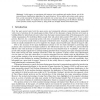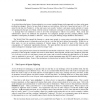CEAS
2004
Springer
14 years 6 months ago
2004
Springer
CEAS
2004
Springer
14 years 6 months ago
2004
Springer
The day to day rhetoric associated with spam control focuses on measures, technology, rules or fees to impose order or control. These efforts concentrate on the broad range of mess...
CEAS
2004
Springer
14 years 8 months ago
2004
Springer
One source major of email addresses for spammers involves “harvesting” them from websites. This paper describes a proposal to allow a website owner to make illegal such automat...
CEAS
2004
Springer
14 years 8 months ago
2004
Springer
The efforts of anti-spammers and spammers has often been described as an arms race. As we devise new ways to stem the flood of bulk mail, spammers respond by working their way ar...
CEAS
2004
Springer
14 years 8 months ago
2004
Springer
Spam-reduction techniques have developed rapidly over the last few years, as spam volumes have increased. We believe that no one anti-spam solution is the “right” answer, and t...
CEAS
2004
Springer
14 years 8 months ago
2004
Springer
Abstract. We present Filtron, a prototype anti-spam filter that integrates the main empirical conclusions of our comprehensive analysis on using machine learning to construct eff...
CEAS
2004
Springer
14 years 8 months ago
2004
Springer
This paper introduces the SpamBayes classification engine and outlines the most important features and techniques which contribute to its success. The importance of using the indet...
CEAS
2004
Springer
14 years 8 months ago
2004
Springer
CEAS
2004
Springer
14 years 8 months ago
2004
Springer
Spam has become a major problem that is threatening the efficiency of the current email system. Spam is overwhelming the Internet because 1) emails are pushed from senders to recei...
CEAS
2004
Springer
14 years 8 months ago
2004
Springer


